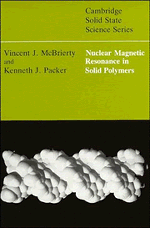Book contents
- Frontmatter
- Contents
- Preface
- Acknowledgements
- Glossary of terms
- 1 The NMR of solid polymers: an overview
- 2 Basic concepts in NMR
- 3 Nuclear spin interactions
- 4 Experimental methods
- 5 Structure and motion in solid polymers
- 6 Structural heterogeneity in polymers
- 7 Oriented polymers
- 8 Selected topics
- Appendix 1 Data on common polymers
- Appendix 2 The rotation operator
- Appendix 3 Rotation of tensors between coordinate frames
- Appendix 4 Spatial distribution of structural units in a polymer
- Appendix 5 The internal Hamiltonian
- Appendix 6 Spectral lineshapes
- Appendix 7 Analysis of spinning sidebands
- Bibliography
- References
- Author index
- Subject index
7 - Oriented polymers
Published online by Cambridge University Press: 19 October 2009
- Frontmatter
- Contents
- Preface
- Acknowledgements
- Glossary of terms
- 1 The NMR of solid polymers: an overview
- 2 Basic concepts in NMR
- 3 Nuclear spin interactions
- 4 Experimental methods
- 5 Structure and motion in solid polymers
- 6 Structural heterogeneity in polymers
- 7 Oriented polymers
- 8 Selected topics
- Appendix 1 Data on common polymers
- Appendix 2 The rotation operator
- Appendix 3 Rotation of tensors between coordinate frames
- Appendix 4 Spatial distribution of structural units in a polymer
- Appendix 5 The internal Hamiltonian
- Appendix 6 Spectral lineshapes
- Appendix 7 Analysis of spinning sidebands
- Bibliography
- References
- Author index
- Subject index
Summary
Introductory remarks
Preferred orientation can arise, either by accident or design, when polymers are subjected to particular fabrication procedures (Ward, 1982, 1985). Mechanical deformation typically induced by drawing, compression or rolling, can lead to anisotropy at the macroscopic level where, in effect, the orientational dependence that characterises the structural units at the molecular level is retrieved in part in the bulk: ultra-high-modulus fibres are notable examples. In other instances, molecular orientation can be achieved by suitable application of electric and magnetic fields and preferred orientation can occur at inter-phase surfaces in heterogeneous polymer systems, as discussed in Section 6.3. On the other hand, unwanted orientation may be induced by rapid spinning as in MAS (Maciel et al., 1985).
In materials as morphologically complex as polymers, one is inevitably concerned with macroscopic averages, or moments, of the distribution of structural units. Clearly it is important to determine such moments if the overall properties of the polymer are to be understood and quantified. The natural inclination is to resort to X-ray analysis which, indeed, has been predictably successful. However, a number of other theoretical and experimental tools have collectively given greater insight into the structure of non-isotropic polymers. Results from a variety of NMR experiments correlate well with each other (Kretz et al., 1988) and with alternative approaches including X-ray analysis (McBrierty et al., 1971b; Windle, 1982; Pietralla et al., 1985; Ward, 1985).
- Type
- Chapter
- Information
- Nuclear Magnetic Resonance in Solid Polymers , pp. 238 - 268Publisher: Cambridge University PressPrint publication year: 1993



